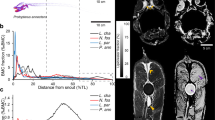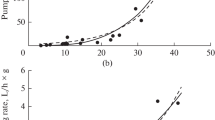Abstract
The principal driving mechanism of perivisceral-fluid circulation was investigated in the echinoid Lytechinus variegatus by metal-clad hot-wire anemometry. Analysis of 23 flow profiles from 13 individuals collected from 1 to 3 m water depth at Tarpon Springs and Sarasota, Florida (USA) in 1984 indicates that for this species, the ciliated epithelium is an ineffective driving mechanism for mixing of the perivisceral fluid. Instead, the Aristotle's lantern is the major driving force of circulation of the perivisceral fluid, with velocity fluctuations of ≦1.5 mm s-1 amplitude in the cavity center during intermittent periods of activity. These fluctuations rapidly decay as the ciliated surfaces are approached. Spectral analysis of velocity time-series reveals predominant energy-containing velocity fluctuations between 0.007 and 0.05 Hz. The circulation, which can be described as non-turbulent forced mixing, has revealed four different flow patterns which appear to be correlated with specific animal activities. A modified eddydiffusion model predicts that oxygen transport through the cavity over a 2 cm path length requires more than 20 h. Calculation of the oxygen flux to a ripe ovary suggests that supply does not meet ovarian oxygen demand in this case. Alternative pathways of oxygen transport invoking advection in perivisceral-fluid eddies and along the ciliated coelomic surfaces are compatible with the observed flow patterns and lead to much shorter oxygen-transport time scales of the order of 1 to 10 min.
Similar content being viewed by others
Literature cited
Bendat, J. S. and A. G. Piersol: Random data: analysis and measurement procedures, 407 pp. New York: Wiley-Interscience 1971
Binyon, J.: Physiology of echinoderms, 264 pp. New York: Pergamon 1972
Blackwelder, R. F.: Hot-wire and hot-film anemometers. In: Methods of experimental physics: fluid dynamics. Vol. 18 Part A, pp 259–314. Ed. by R. J. Emrich. New York: Academic Press 1981
Blackwelder, R. F. and H. Eckelmann: Influence of the convection velocity on the calibration and linearization of heated surface elements. Ber. Max-Planck-Inst. Strömungsforsch. 120, 1–10 (1977)
Boolootian, R. A. and A. C. Giese: Clotting of echinoderm coelomic fluid. J. exp. Zool. 140, 207–229 (1959)
Bradshaw, P., D. H. Ferriss and N. P. Atwell: Calculation of boundary-layer development using the turbulent energy equation. J. Fluid Mech. 28, 593–616 (1967)
Brennen, C. and J. Winet: Fluid mechanics of propulsion by cilia and flagella. A. Rev. Fluid Mech. 9, 339–398 (1977)
Brigham, E. O.: The fast Fourier transform 252 pp. New York: Prentice-Hall 1974
Buchanan, J. B.: Feeding and the control of volume within the tests of regular sea-urchins. J. Zool., Lond. 159, 51–64 (1969)
Buddington, T. A.: The ciliary transport-system of Asterias forbest. Biol. Bull. mar. biol. Lab., Woods Hole 83, 438–450 (1942)
Chesher, R. H.: Contributions to the biology of Meoma ventricosa (Echinoidia: Spantangoida). Bull. mar. Sci. 19, 72–110 (1969)
Eckart, C.: An analysis of the stirring and mixing processes in incompressible fluids. J. mar. Res. 7, 265–275 (1918)
Ernest, R. G.: Reproductive variability in Lytechinus variegatus (Echinodermata: Echinoidea) from different habitats in a Florida west coast estuary, 103 pp. M.S. thesis, University of South Florida 1979
Farmanfarmaian, A.: The respiratory physiology of echinoderms. In: Physiology of Echinodermata, pp 245–265. Ed. by R. A. Boolootian. New York: John Wiley 1966
Gust, G.: Tools for oceanic small-scale high-frequency flows: metal-clad hot wires. J. geophys. Res. 87, 447–455 (1982)
Gust, G. and G. L. Weatherly: Velocities, turbulence and skin friction in a deep-sea logarithmic layer. J. geophys. Res. 90, 4779–4792 (1985)
Hanson, J.: Hydrodynamics of perivisceral fluid circulation in the sea-urchin Lytechinus variegatus with special reference to material transport, 64 pp. M.S. thesis, University of South Florida 1985
Hyman, L. H.: The invertebrates. Vol. 4. Echinodermata, 763 pp. New York: McGraw-Hill 1955
Jensen, M.: Functional morphology of test, peristome, lantern and tube feet in flexible and rigid sea urchins (Echinoidea). In: Echnodermata, pp 281–288. Ed. by B. F. Keegan and B. D. S. O'Connor. Rotterdam: A.A. Balkema 1985
King, L. V.: On the convection of heat from small cylinders in a stream of fluid: determination of the convection constants of small platinum wires with application to hot-wire anemometry. Phil. Trans. R. Soc. A214, 373–432 (1914)
Klinger, T. S.: Feeding of a marine generalist grazer: Lytechinus variegatus (Lamarck) (Echinodermata: Echinoidea), 216 pp. Ph.D. dissertation. University of South Florida 1984
Moore, H. B. and B. F. McPherson: A contribution to the study of the productivity of the urchins Tripneustes esculentus and Lytechinus variegatus. Bull. mar. Sci. 15, 855–871 (1965)
Riley, J. P. and R. Chester: Introduction to marine chemistry, 465 pp. New York: Academic Press 1971
Shick, J. M.: Respiratory gas exchange in echinoderms. In: Echinoderm studies, pp 67–110. Ed. by M. Jangoux and J. M. Lawrence. Rotterdam: A.A. Balkema 1983
Spiegel, M. R.: Theory and problems of statistics 359 pp. New York: McGraw-Hill 1961. (Schaum's Publishing Outline Ser.)
Tennekes, H. and J. L. Lumley: A first course in turbulence, 300 pp. Cambridge: MIT Press 1972
Walker, C. W.: Ultrastructure of the somatic portion of the gonads in asteroids, with emphasis on flagellated-collar cells and nutrient transport. J. Morph. 162, 127–161 (1979)
Webster, S. K. and A. C. Giese: Oxygen consumption of the purple sea urchin with special reference to the reproductive cycle. Biol. Bull. mar. biol. Lab., Woods Hole 148, 165–180 (1975)
Author information
Authors and Affiliations
Additional information
Communicated by J. M. Lawrence, Tampa
Rights and permissions
About this article
Cite this article
Hanson, J.L., Gust, G. Circulation of perivisceral fluid in the sea urchin Lytechinus variegatus . Marine Biology 92, 125–134 (1986). https://doi.org/10.1007/BF00392754
Accepted:
Issue Date:
DOI: https://doi.org/10.1007/BF00392754




